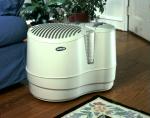Search engine visitors - click here to access entire "$ensible Home" web site
Click here to see a descriptive illustration showing several designs of effective humidifiers.
Dear Jim: The air in my house gets very dry during the winter even with a furnace-mounted humidifier. I get static shocks from whatever I touch. Will also using some smaller humidifiers help and which types are best? - Sue W.

A: Using a furnace-mounted, whole-house humidifier can be effective, but it is often wise to supplement it with one or several smaller portable room-size units. A furnace-mounted humidifier operates only when the furnace is running, so on milder days, it may not produce constant, even humidity.
There is a proper humidity level range for a home. In this range, you can set your furnace thermostat lower for energy savings and still be comfortable. If is too humid, windows sweat, mold forms and dust mites thrive. If it is too dry, it is uncomfortable and unhealthy microbes may grow.
The proper indoor humidity level also varies with the outdoor temperature. Generally, as the outdoor temperature drops, you should lower the indoor humidity.
For homes without a furnace-mounted humidifier, there are high-capacity freestanding models available. These are usually console styles that produce enough moisture to adequately humidify up to a 3,000 sq. ft. home. Moisture has a natural tendency to migrate throughout a house.
In your home, it sounds like adding a couple smaller portable models is your best choice. There are many designs and styles from which to choose at home centers. You will probably want different types for different rooms, such as a quiet one for a bedroom.
Evaporative humidifiers are one of the most effective designs. With this design, a large wick (very porous pad) rests in a water reservoir. The water is drawn into it by a natural wicking action and a small internal fan blows air through it. Some models also include an air cleaner to remove allergens.
Evaporative models are easy to clean by lifting off the top and removing the wick. Periodic cleaning is important to eliminate mold and microbe growth. Some wicks are replaceable and others are washable. Consider selecting a model that uses a wick made of an antimicrobial material.
Another effective type is a warm mist humidifier. These boil the water so bacteria and viruses are not a concern and combine its output with room air to cool it. The exterior stays cools so they are safe around children. Since it heats the water, this type uses more electricity than some others.
Cool mist humidifiers use a mechanical action to produce the water vapor. A fast-moving impeller throws the water into a screen to create the fine water droplets. You may find a white dust on nearby surfaces in hard water areas. Ultrasonic models are quiet, but you may also find some white dust.
Instant Download Update Bulletin No. 649 - buyer's guide of 10 humidifiers, designs (tabletop, console), selector guide of various humidifier types shoqing illustration of evaporative, warm steam, steam mist, cool mist, ultrasonic, description of how the differnt types of units work, advantage and disadvantages of each type, outputs, features, humidification sizing chart and a chart showing maximum indoor humidity levels to avoid window condensation.
Dear Jim: I am planning to install maintenance-free fiberglass shutters on my house. The house has vinyl siding. Should I be concerned about drilling through the siding and the air barrier to mount the shutters? - Carl T.
A: It is always better to have as few penetrations through the exterior envelope of a house as possible, but hanging some shutters should be fine. It is done all the time without causing problems.
Vinyl siding is hung loosely so it can expand and contract with temperature changes. Don't nail the shutters too tightly and trap the siding. Also make clearance holes in the siding that are slightly larger than the nails or screws.